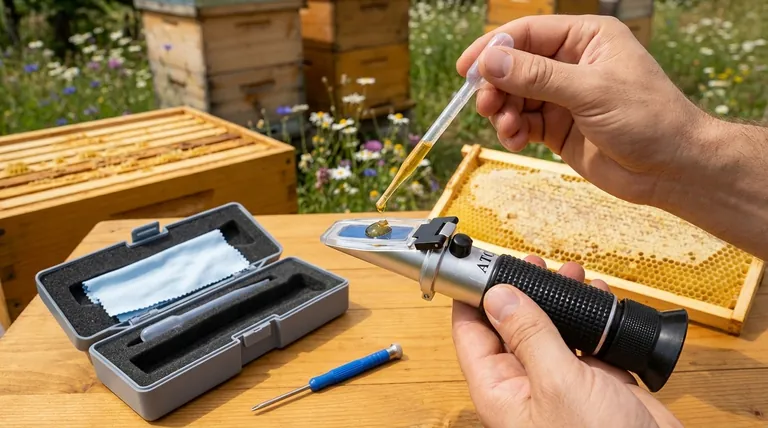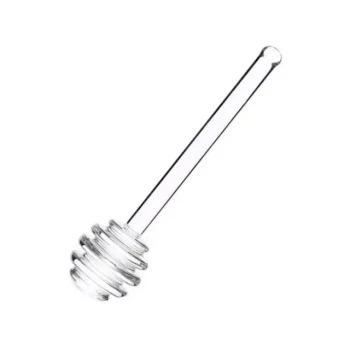The short answer is: very little. Once nectar is sealed in a honeycomb cell, the transformation is essentially complete. This final step is not about changing the nectar, but about preserving the finished honey for long-term storage, protecting it from moisture and contaminants.
The sealing of a honeycomb cell is the final act of preservation, not transformation. The true magic—the conversion of watery nectar into dense, stable honey—happens before the wax cap is applied, through a combination of enzymatic chemistry and deliberate dehydration.

The Journey from Flower to Honey
To understand what happens after sealing, we must first understand the intricate process that leads up to it. The creation of honey is a multi-step engineering feat performed by the entire colony.
Step 1: Nectar Collection and Chemical Addition
A forager bee collects nectar from flowers and stores it in a special organ called the honey stomach, or crop. This is not a digestive stomach but a biological transport pouch.
Inside this honey stomach, the bee adds a critical enzyme called invertase. This begins the first major chemical change, breaking down the complex sucrose of the nectar into two simpler sugars: glucose and fructose.
Step 2: Passing the Nectar and Adding More Enzymes
Back at the hive, the forager regurgitates the nectar mixture and passes it to a "house bee." This process may be repeated multiple times, from bee to bee.
With each transfer, more enzymes are added. One of the most important is glucose oxidase, which helps create gluconic acid and hydrogen peroxide when the nectar is still diluted. This makes the environment acidic and hostile to microbes.
Step 3: Dehydration by Fanning
The house bees deposit the enzyme-rich nectar into open honeycomb cells. At this point, the nectar still has a very high water content, often over 70%.
To create stable honey, the bees must reduce this water content to below 18%. They achieve this through dehydration, fanning their wings vigorously at the hive entrance and over the comb to create airflow and evaporate the excess water.
The Final Stage: Sealing and Curing
Only when the honey has reached the optimal water concentration do the bees move to the final step.
Step 4: Capping the Cell
The bees produce fresh beeswax and use it to build an airtight cap over the cell. This seal is the answer to the initial question: its purpose is to protect the finished product.
Sealing the honey prevents it from absorbing moisture from the air, which would cause it to ferment. It also keeps out dirt and other potential contaminants.
What Happens Inside the Sealed Cell?
The major chemical reactions are finished. The sealed honey is now a stable, supersaturated solution of sugars in an acidic, low-water environment.
This phase is best described as curing or maturation. While no significant new chemical changes occur, the complex flavors of the honey can continue to develop and meld over time, much like a fine wine aging in a bottle.
Understanding the Trade-offs: Why Every Step Matters
Each stage of the honey-making process is a defense against spoilage. Understanding these steps reveals why pure, properly cured honey is one of nature's most stable foods.
The Problem of Bacteria and Yeast
Nectar is a sugary liquid, making it a prime target for bacteria and yeast. The bees' process systematically neutralizes this threat.
The Bees' Three-Part Solution
-
Acidity: The addition of gluconic acid lowers the honey's pH to between 3.5 and 4.5, an acidic range that inhibits most bacterial growth.
-
Low Water Content: By reducing water to below 18%, the bees create a high-sugar environment. Through osmosis, this hypertonic solution draws water out of any microbe that lands in it, killing it.
-
Antiseptic Properties: The hydrogen peroxide produced by the glucose oxidase enzyme acts as a natural antiseptic during the honey ripening process, further cleaning the developing honey.
Making the Right Choice for Your Goal
Understanding this process allows you to better appreciate the final product, whether you are a producer or a consumer.
- If you are a beekeeper: Your primary focus is ensuring the bees have fully dehydrated and capped the honey before you harvest. Harvesting "unripe" or uncapped honey with high water content will lead to fermentation and spoilage.
- If you are a honey enthusiast: You can appreciate that "raw" honey contains the beneficial enzymes, like invertase and glucose oxidase, that the bees added. These are often destroyed during high-heat pasteurization.
- If your primary focus is food science: The key takeaway is that honey is a manufactured product, engineered by bees to be shelf-stable through controlled acidity and extremely low water activity.
Ultimately, the sealing of the comb is the colony's final signature on a masterpiece of natural chemistry and collaborative work.
Summary Table:
| Stage | Key Process | Bee's Role | Outcome |
|---|---|---|---|
| 1. Collection | Nectar gathered from flowers. | Forager bee adds enzyme invertase. | Sucrose begins breaking down into glucose & fructose. |
| 2. Ripening | Nectar passed between bees. | House bees add more enzymes (e.g., glucose oxidase). | Acidity increases; microbial defense begins. |
| 3. Dehydration | Water evaporation in open cells. | Bees fan wings to create airflow. | Water content reduces from ~70% to below 18%. |
| 4. Sealing | Cell is capped with beeswax. | Bees create an airtight seal. | Honey is preserved, protected from moisture and contaminants. |
Ready to Support Your Apiary's Success?
For commercial apiaries and beekeeping equipment distributors, the quality of your harvest depends on the health of your hive and the efficiency of your equipment. HONESTBEE supplies the durable, high-performance beekeeping supplies and wholesale equipment you need to manage every step of the honey-making process—from nectar collection to the final sealing of the comb.
Let us help you achieve a superior, stable harvest. Contact our expert team today to discuss your wholesale needs and discover how our products can enhance your operation's productivity and honey quality.
Visual Guide

Related Products
- Precision Honey Refractometer Instrument for Quality Assessment
- Digital Honey Refractometer for Precision Measurement of Optimal Honey Quality
- Premium Heat-Resistant Glass Honey Dipper
- Natural Wood Honey Dipper for Tea Coffee and Desserts
- Modern Honeycomb Pattern Wooden Honey Dipper for Stirring and Drizzling
People Also Ask
- How does a honey refractometer work? Ensure Honey Quality & Harvest Readiness
- Why is a honey refractometer considered essential for commercial beekeepers? Ensure Honey Quality and Profitability
- What are the features of the Standard Refractometer for honey moisture content? Essential Tools for Quality Control
- What is a honey refractometer and what is its purpose? Ensure Honey Quality and Prevent Spoilage
- What is a honey refractometer? The Essential Tool for Perfect Honey Quality



















